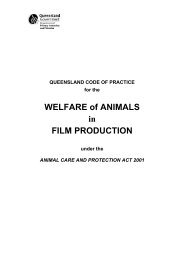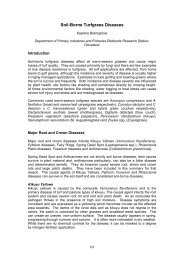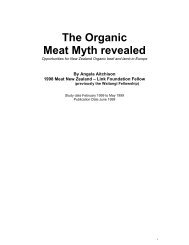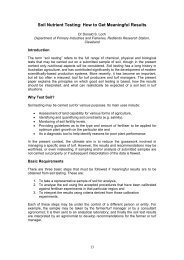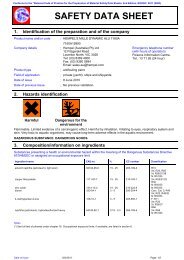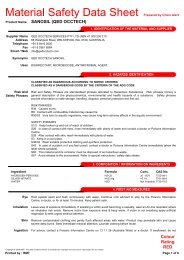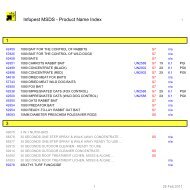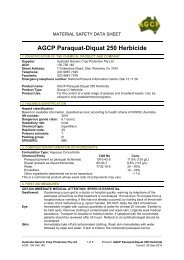Study Sites
Study Sites
Study Sites
Create successful ePaper yourself
Turn your PDF publications into a flip-book with our unique Google optimized e-Paper software.
Biology, management and genetic stock structure of mangrove jackMethods<strong>Study</strong> <strong>Sites</strong>Locations at the tidal influenced brackish-freshwater interface were selected as monthlysampling sites in four north Queensland rivers, and quarterly sampling sites were selected inrivers through Central and Southern Queensland (Map 1). Criteria for these choices included;distance to river mouth, habitat diversity, tidal range and flow, seasonal salinity levels andvessel access. Seasonal river flow levels, and resultant salinities influenced access andelectrofishing effectiveness particularly during periods of dry weather. Three replicates ateach site, each typically 300m in length were selected. This distance allowed an average 1500seconds electrofishing time which was found to be sufficient to capture a minimal number offish. The boundaries of sites were identified by familiar bank side structures that wererecorded by GPS for repeat visits. Where possible, a site on the brackish interface and anupstream site in each river were used to investigate within-river movement.Daintree RiverMulgrave RiverRussell RiverHerbert RiverCoral SeaCrystal CreekO'Connell RiverQUEENSLAND0 100 200Kilometres*Raglan CreekBoyne RiverBaffle CreekMap 1. Location of study areas in Queensland.11
Biology, management and genetic stock structure of mangrove jackMap 1 shows the locations of the main study locations where mangrove jack were sampledeither monthly or quarterly using electrofishing techniques. Detailed descriptions of theselocations follow:Daintree RiverThe Daintree River, which is the northern most catchment, has its source in the Main CoastRange and is surrounded by the Thornton and McDowall Ranges and drains a small coastalplain before discharging into the Coral Sea (Map 2). These ranges are mostly rainforestcovered, although there are some areas of dry sclerophyll in the west of the catchment. Thetotal catchment area is about 1342 km 2 and the township of Daintree (estimated population of100) is its only significant population centre. The mean annual river discharge is about 907000 ML with an average annual rainfall runnoff of 997 mm (N. Searle, Department of NaturalResources and Mines, pers. comm.). Most of the catchment is included in the Wet TropicsWorld Heritage area (Russell et al., 1998).Daintree River0*05 10KilometresMap 2. Daintree River.Cross-hatched area shows location of study sites in.Russell and Mulgrave RiversThese are perennial waterways that drain the coastal ranges and alluvial flood plains to thesouth of Cairns. The two rivers flow into Mutchero Inlet before discharging into the Coral Seathrough a common mouth (Map 3). The alluvial plain varies in width from about 3 to 13 kmand is bounded on the west by the Bellenden Ker Range, to the north and west by the LambRange, to the east by the Malbon Thomson and Graham Ranges and to the south by theFrancis Range. The Bellenden Ker Range contains Mt Bartle Frere and Mt. Bellenden Ker,the two highest mountains in Queensland. Total catchment area, for both rivers, isapproximately 1,370 km 2 . The Russell River is approximately 65 km long and has a totalcatchment area of 560 km 2 . It rises in the Bellenden Ker Ranges and on the AthertonTableland and has a mean annual discharge of about 940,000 ML (Department of NaturalResources and Mines, pers. comm.). The Mulgrave River also rises in the Bellenden Ker12
Biology, management and genetic stock structure of mangrove jackRanges and has a total catchment area of 810 km 2 . Mean annual average discharge of theMulgrave River is about 770,000 ML (Department of Natural Resources and Mines, pers.comm.). The majority of the catchment is rugged mountain range and remains in a relativelypristine state. Approximately 66% of the total area of the catchment is protected as part of theWorld Heritage Estate. Much of the coastal plain and some tableland areas have beendeveloped for agriculture. While sugar cane farming is the major agricultural activity on thecoastal belt, bananas, pawpaws and exotic tropical fruits are also grown. Tea, pastures andgrazing are the predominant agricultural activities on the Tablelands. The catchment has oneof the wettest climates in Australia with most of the rain falling during the warm summermonths. Rainfall statistics for the two major townships in the catchment, Babinda (17°21'S,145°55'E) and Gordonvale (17°06'S, 145°47'E) are given in Table 1.Table 1. Annual rainfall statistics for Babinda and Gordonvale Post Offices.LocationPeriodAverage Maximum(mm) (mm)Babinda (Russell Catchment) 1911-1994 4,175 6,714Gordonvale (Mulgrave Catchment) 1963-1994 1,921 3,219Mulgrave RiverMutchero InletMap 3. Russell and Mulgrave River sites.*0 10 20KilometresCross-hatched area shows location of study sites.Russell RiverNorth Johnstone RiverJohnstone RiversThe Johnstone River flows into the Coral Sea near the sugar town of Innisfail (17 o 32'S, 146 o02'E). The river bifurcates about 5 km from the mouth into the North and South JohnstoneRivers, both of which have their sources on the Atherton Tablelands (Map 4). The highestpart of the catchment is on the Atherton Tablelands and is 1385 m above sea level. TheAtherton Tablelands and the coastal plain are separated by steep, heavily forested uplands13
Biology, management and genetic stock structure of mangrove jackwhere the river flows through deep gorges and is characterised by the presence of rapids andwaterfalls. The Johnstone catchment, which has an area of approximately 1634 km 2 , has anannual average rainfall of between 1690 and 3970 mm. Average annual runnoff was 2.7million ML (Department of Natural Resources and Mines, pers. comm.). Land use is variedthroughout the catchment. On the Tablelands dairying is the predominant landuse while sugarand banana farming are the main agricultural activities on the coastal belt. About 43% of thecatchment, mainly the coastal range, is protected under World Heritage listing. In 1991/92agricultural production in the catchment was estimated to be worth $170 million.KilometresNorth Johnstone RiverSouth JohnstoneRiver*0 10Kilometres20Map 4. Johnstone River sites.Cross-hatched area shows location of study sites.Hinchinbrook IslandHerbert RiverCrystal Creek*0 10 20KilometresHerbert RiverMap 5. Herbert River and Crystal Creek sites.Cross-hatched area shows location of study sites.The Herbert River flows into the Coral Sea near the southern end of Hinchinbrook Island nearthe small communities of Halifax and Lucinda (Map 5). The total catchment area is 9843 km 214
Biology, management and genetic stock structure of mangrove jackwith an average annual runoff of 407 mm/m 2 and a mean annual discharge of 4 km 3(GBRMPA, 2001). The nearest large population centre is the sugar town of Ingham (18 o 39’S,146 o 11’E) which has an average annual rainfall of 2122.2 mm. The major landuse in thecatchment is grazing (7330 km 2 ) with most of the narrow coastal plain under intensiveagriculture predominantly sugar cane farming (691 km 2 )(GBRMPA, 2001). Electrofishingactivities were carried out around the upper limit of tidal influence.Crystal CreekThis small coastal creek drains the Paluma Ranges into Halifax Bay (Map 5). Flows areconsiderably reduced or cease during the dry winter and spring months. Reduced freshwaterflows during these periods resulted in increased salinity and either reduced the effectivenessof, or prohibited the use of electrofishing apparatus at the designated sampling sites.O’Connell RiverThe O’Connell River drains into Repulse Bay about 22 km to the south of the sugar town ofProserpine (20 o 27’S, 148 o 35’E) in central Queensland (Map 6). The river has a mean annualdischarge of 1.5 km 3 and an annual runoff of 645 mm/m 2 (GBRMPA, 2001). The catchmentis relatively small (2387 km 2 ) and is 51% cleared. Grazing is the major landuse (1904 km 2 )followed by sugar cane farming (264 km 2 ). The river is shallow and sandy and during the dryseason a series of temporary sand dams are constructed in its lower reaches to provideirrigation water and also limit the penetration of tidal waters.O'Connell River*0 10 20KilometresMap 6. O'Connell River sites.Cross-hatched area shows location of study sites.Upper Raglan CreekRaglan Creek flows into the delta of the Fitzroy River at Port Alma to the south ofRockhampton (Map 7). The Fitzroy River, with a catchment of 140,000 km 2 , is the largestriver draining central Queensland and has an average annual discharge of 5220 million cubicmetres (Australian Water Resources Council, 1976). A barrage has been constructed acrossthe river close to the city of Rockhampton, about 60 km upstream from the mouth. Much ofthe tidal reach of Raglan Creek has a thin fringe of mangroves that backs onto extensive salt15
Biology, management and genetic stock structure of mangrove jackpans. The substrate is mainly mud and maximum tidal amplitude is around 5 m. Samplingwas undertaken in a water hole in the upper reaches which is only connected to the maincreek in large high tides or during periods when there is freshwater discharge.Casuarina CreekInkerman Creek*Raglan Creek010Kilometres20Map 7. Raglan Creek sites.Cross-hatched area shows location of study sitesCalliope RiverThe catchment area of the Calliope River is approximately 2150 km 2 of which 83% has beencleared for agriculture (GBRMPA, 2001). Grazing is the major landuse covering about 2032km 2 (95%) of the total catchment area. The river has a mean annual discharge of 0.3 km 3 anda runoff of 134 mm/m 2 (GBRMPA, 2001). It originates in the Calliope Range approximately100 km to the east of its mouth near the port city of Gladstone (Map 8). The river has noartificial stream barriers that would inhibit fish movements (McKinnon et al., 1995).Raglan CreekCalliope River*0 10 20KilometresMap 8. Calliope River.Cross-hatched area shows location of study sites.16
Biology, management and genetic stock structure of mangrove jackBaffle CreekBaffle Creek drains into the Pacific Ocean on the central Queensland coast about 44 km northof the sugar city of Bundaberg (24 o. 52’S, 152 o. 21’E) (Map 9). Two small fishingcommunities, Boaga and Winfield, are established on the southern side of the estuary. Thecatchment has an area of about 3996 km 2 , a mean annual discharge of 0.8 km 3 and an averagerunoff of 195 mm/m 2 . The predominant landuse in the catchment is grazing (87% of totalcatchment area) but other minor landuses include sugar cane farming (14 km 2 ) andhorticulture (8 km 2 ) (GBRMPA, 2001). State Forests and Timber Reserves occupy 477 km 2and protected areas cover 214 km 2 of the catchment. It has a wide sandy estuary whichnarrows to a small mouth but the upper estuarine and brackish reaches contain isolated rockbars and the channels are deeper and slower moving than the lower estuarine areas. The bar ofthis creek is exposed to south-east trade winds and also experiences strong tidal currents. Themaximum tidal amplitude is about 3m and tidal influence extends 32 km upstream to theEssendean road bridge (24 o 31.06’S, 152 o 03.23’E). This is also the upper limit of wheresampling with the electrofisher was undertaken and, depending on seasonal variations in thesalinity of the river, extended up to 12 km downstream. The Baffle system is one of the fewremaining waterways in the Wide Bay-Burnett region that has no weirs, barrages or otherartificial structures that disrupt fish migrations, regulate flows downstream or interfere withtidal flow (Lupton and Heidenreich, 1996).Euleilah Creek*Baffle CreekBottle CreekEssendeanBridge0 10 20KilometresField sampling techniquesHabitat AssessmentMap 9. Baffle Creek.Cross-hatched area shows location of study sites.Analysis of in-stream and riparian habitat for each site was conducted according to aproforma used by Russell (2000), as presented in Appendix 2. Percentages of habitatcategorised as grass, macrophyte, overhanging vegetation, rock, root and snag were estimatedfor each replicate. In addition other factors such as stream width, depth, width of riparianvegetation, presence of mangroves and level of disturbance and sedimentation were alsorecorded. GPS co-ordinates for replicate start and finish locations were recorded using aGarmin GPS12 unit.17
Biology, management and genetic stock structure of mangrove jackWater QualityRecordings of ambient water quality parameters at the time of electrofishing surveys weretaken at a depth of 0.5m with a Horiba ®U-10 meter. Parameters recorded were pH,Conductivity (mS/cm), Temperature (°C), salinity, Turbidity (NTU) and Dissolved Oxygen(DO mg L -1 ). During periods of higher salinities, additional readings were taken at the bottomof the water column to confirm if electrofishing would be efficient.ElectrofishingA 4.3m electrofishing boat equipped with a Smith-Root® Model 7.5 GPP generator was usedas the survey vessel, using a pulsed direct current. Conductivity at the site determined thesettings required for efficient operations, with voltages ranging from 135-1 000 V DC. Ateach site, the vessel was manoeuvred upstream slowly covering the area adjacent to the bank..The effective stunning radius and depth were approximately 5 metres and 3 metresrespectively, although these distances decreased with increasing salinity. The boat wasmanoeuvred such that the anodes were always in close proximity to suitable habitat. All L.argentimaculatus were netted with 3 metre-long handle dipnets, and placed in a 100Lrecirculating live tank onboard the vessel. Some stunned mangrove jack were carried by anystream flow and may have moved out of the effective stunning range before they could benetted. These fish were recorded on the datasheet with an approximate size. Captured fishwere measured and assigned to one of the following niche types; Snag, overhangingvegetation, roots, rock, macrophyte or grass. At the completion of each replicate, all fish weremeasured, weighed, tagged and released.TaggingFor L. argentimaculatus between 120 and 300mm, a Hallprint type TBF-2 (45mm) fineanchor T-Bar tag was inserted between the pterygiophores of the secondary soft dorsal finrays using an Avery Dennison Mark III tag applicator. For fish greater than 300mm aHallprint type PDT (85mm) dart tag was inserted between the posterior pterygiophores of thefirst dorsal fin spines using a hollow tag needle. All tagging was done on the left-hand side.In all tagging operations, a scale was lifted from the insertion point, the needle was depressedthrough the flesh until the point passed through the pterygiophores of the dorsal rays and theneedle was withdrawn. Tags were then pushed into the flesh and then withdrawn slightly toensure correct application. Where the first tag was either not placed correctly or was broken,a second tag was inserted to the rear of this location.To help to determine the rate of tag loss, tag-shedding experiments were conducted in pondsin Townsville and Walkamin. Some double-tagging of wild fish was conducted in CrystalCreek and the Barron River to attempt to compare shedding rates with the pond experiments.Measuring and WeighingFish were placed on an on-board measuring board associated with the live tank. This boardwas kept continuously moist to ensure minimal loss of slime on fish. Total fish length (TL)and fork length (LCF) in millimetres was measured for the first 1500 fish captured to producea correlation to be used to correct recreational fisher recapture lengths. After this time onlyLCF was recorded.Whole wet weight of live specimens was measured to 1gm using an Arlec (Model DS102)portable digital balance with a custom-built PVC measuring pan which included a moistenedtowel to facilitate fish health by reducing slime loss. Where fish were larger than 2 kg, 5 kgSalter ® hanging spring balances were used.18
Biology, management and genetic stock structure of mangrove jackScalesOn the first occasion a L. argentimaculatus was captured and tagged, a couple of scales wereremoved by fine forceps from the left-hand side of the body, from an area covered by thepectoral fin. In recaptured fish, scales were removed from the right hand side of the fish anda check was made that these were not regrowth scales. Samples were also obtained from reefsize fish collected by commercial fishers. All scales were stored in small paper envelopes,marked with tag numbers or specimen numbers, air-dried and stored.OtolithsOtoliths were removed from most fish that were sampled from the commercial andrecreational fishery or were sacrificed in the research program. A full description of theprocess of sampling, sectioning and reading otoliths is given in the Age and Growth chapter.Otoliths were also supplied to a post graduate student at James Cook University to determineif microchemical analyses could be used to identify inshore juvenile habitats (see Appendix3).Euthanasia and AnaestheticsMangrove jack specimens required for laboratory studies were pithed via a knife woundthrough the roof of the buccal cavity penetrating the brain cavity followed by severance of thethoracic artery. Fish were then placed in an ice slurry to reduce metabolism until they couldbe dissected. Handling of fish during transport or injection was aided by use of AquaS orBenzocaine solution at recommended rates.Animal ethicsAnimal ethics approvals were obtained for all field-sampling activities.Laboratory techniquesSamplesSpecimens of L. argentimaculatus were collected by researchers, commercial and recreationalfishers from various locations within Australia and overseas. Material supplied included,whole fish, frames, heads or fin clips for genetic analysis. Fish frames were generally frozenand stored at NFC at -21°C. Weekly samples of fresh frozen L. argentimaculatus from theGBR adjacent to Cairns were supplied by the seafood processor, “A Fine Kettle of Fish”(FKOF).Fish frames and heads were defrosted in running water and dissected at NFC. Total fishlength (TL) and fork length (LCF) Opercular length (OL) was recorded and the sampledissected to retrieve otoliths, gonads, scales and genetic material.ReproductionGonad tissue, including the associated fat body attaching the gonad to the swim bladder andliver, were dissected from the body cavity. A stage of development was assigned to eachgonad using characters according to Davis (1982). Fat and gonad were separated andweighed on a Mettler PC 4400 balance to nearest 0.01gm. Gonad tissue was fixed whole in10% formal saline (100ml 38% formalin, 450ml distilled water, 450ml 30µm filteredseawater) prior to sectioning. Larger gonads were cut or punctured to allow influx of fixative.Medial sections (1cm 2 by 3mm thick) of gonads were cut with a scalpel and stored in alabelled histocassette in 10% formal saline fixative.Staining and mounting of 3µm sections using Lillies-Mayers Haematoxylin and Eosin withPhloxine was completed by DPI Animal & Plant Health, Oonoonba Veterinary Laboratoryand Queensland Health Pathology and Scientific Services, Cairns Base Hospital (QHPSS).19
Biology, management and genetic stock structure of mangrove jackMedial, dorsal and proximal sections for a number of gonads were initially sectioned forcomparison of development within a gonad but medial sections were deemed suitable forfurther investigations. Staff at NFC analysed these sections using a Leica DMLB brightfield-illuminated microscope. The quality of section, percentage of cell types and ranking ofmaturity was recorded in a MS Access database. For mature stage females, a picture ofapproximately 15 developed oocytes was taken using a Leica digital camera. Measurementof maximum oocyte diameter for late stage MNS and hydrated oocytes was done usingUTHSCA © Image Tool for Windows Ver.2.Genetic samplesA 5mm long section of a soft fin ray of the secondary dorsal fin was removed with a pair offine point scissors and stored in a numbered vial containing DSMO fixative. Samples werekept cool and refrigerated when returned to the laboratory. Samples were collected from bothlive specimens and from dead/frozen samples dissected in the laboratory. These sampleswere then sent to the Genetics laboratory at the Southern Fisheries Centre (SFC) for analysis.A field kit containing instructions, scissors, forceps and datasheet was given to recreationalfishers helping to collect samples from isolated or estuarine habitats.Data AnalysisField and laboratory data were collated in a MS Access ® database, with graphicalrepresentation of data plotted using MS Excel ® and SigmaPlot ® . All tagging data wasincorporated into the Suntag database. Summaries of catch information for mangrove jack ateach site are given in Appendix 4.20





